
Heavy Metal Accumulation in Lettuce (Lactuca Sativa L.) Amended with Different Amounts of Fresh Broiler Poultry Manure
*Corresponding Author(s):
Masarirambi MTDepartment Of Horticulture, University Of Eswatini, Eswatini, South Africa
Tel:+268 76128026,
Email:thabomsibeko@yahoo.com
Abstract
INTRODUCTION
Poultry manure is one of the commonly used forms of manure mainly because of its availability from local poultry farms; it has been used for centuries because of its high nitrogen content [2]. The frequent clean out of many poultry houses makes poultry manure available in sufficient quantities and on timely basis to supply most fertilizer needs [2], Poultry litter is made up of raw poultry manure and bedding material like sawdust, wood shavings, grass cuttings, banana leaves or rice hulls. This combination provides a good source of NPK including heavy metals [3]. The general objective of this study was to improve food security by providing information on the use of fresh broiler manure to produce healthy leafy vegetables especially lettuce in the greenhouse environment in Swaziland.
The specific objectives of the experiment were:
Swaziland imports 80% of fruits and vegetables it consumes from neighboring South Africa. As an economy, Swaziland faces a tough challenge to increase food production and food security by increasing production locally. To realize this vision, it is about time that greenhouse vegetable production be taken to a commercial level. In green houses, broiler manure at the correct application rate may be used to increase production whilst cutting down costs and reducing waste without causing harm to the environment and human health. The use of poultry manure has increased; however, the potential of heavy metal contamination has not been studied.
MATERIALS AND METHODS
Experimental site
Plant material
Experimental design
|
Block 1 |
Block 2 |
Block 3 |
|||
|
40t/ha |
0t/ha |
60t/ha |
20t/ha |
0t/ha |
60t/ha |
|
60t/ha |
20t/ha |
0t/ha |
40t/ha |
20t/ha |
40t/ha |
|
Treatment Code |
Treatment Description |
Rate of Application |
|
1 |
Control |
0t/ha |
|
2 |
Broiler manure |
20t/ha |
|
3 |
Broiler manure |
40t/ha |
|
4 |
Broiler manure |
60t/ha |
The soil in the experimental rows/plots and fresh broiler manure were randomly sampled and analyzed at the Malkerns Research Station, for fertilizer recommendation before the start of the experiment (Table 3).
|
Texture |
pH |
Exchangeable Acidity (meq/100g) |
N (mg/kg) |
P (mg/kg) |
K (mg/kg) |
|
Manure |
7.9 |
0.39 |
165 |
1965 |
1900 |
|
Soil |
6.2 |
0.24 |
6.7 |
39 |
100 |
DATA COLLECTION
Determination of the basic properties of the soil
Determination of the soil pH
Determination of pH of fresh manure used in this study
The determination of exchangeable Ca, Mg and K
Determination of exchangeable Aluminium (Al)
Determination of available phosphorus in the soil
Lettuce analysis
Nitric digestion method
|
Parameter |
Mn |
Fe |
Zn |
Cd |
Cu |
|
Wave length (nm) |
279.5 |
248.3 |
213.9 |
228.8 |
234.8 |
|
Slit width (nm) |
1.0 |
2.0 |
1.0 |
0.5 |
0.5 |
|
Lamp current (mA) |
10 |
30 |
5 |
4 |
4.0 |
|
Cu |
Cd |
Mn |
Fe |
Zn |
|
0.5 |
0.5 |
1.0 |
0.5 |
0.5 |
|
1.0 |
1.0 |
2.0 |
1.0 |
1.0 |
|
2.0 |
2.0 |
3.0 |
2.0 |
2.0 |
|
3.0 |
3.0 |
4.0 |
3.0 |
3.0 |
|
4.0 |
4.0 |
5.0 |
4.0 |
4.0 |
Data analysis
RESULTS
Fresh mass yield
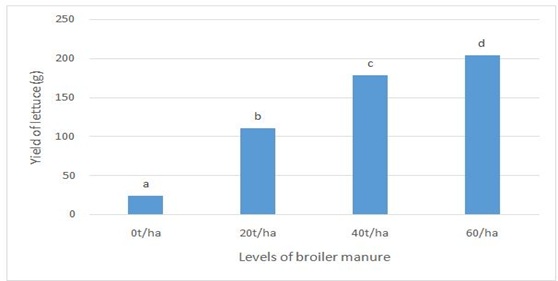 Figure 1: Fresh mass of lettuce (Lactuca sativa) plants amended with various amounts of fresh broiler manure. Bars with same letters not significantly different from each other at P=0.05. Mean separation by DNMRT.
Figure 1: Fresh mass of lettuce (Lactuca sativa) plants amended with various amounts of fresh broiler manure. Bars with same letters not significantly different from each other at P=0.05. Mean separation by DNMRT.Dry mass
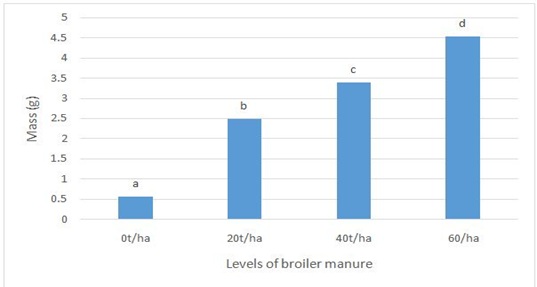 Figure 2: Dry mass of lettuce (Lactuca sativa) plants amended various amounts of fresh broiler manure. Bars with same letters not significantly different from each other at P=0.05. Mean separation by DNMRT.
Figure 2: Dry mass of lettuce (Lactuca sativa) plants amended various amounts of fresh broiler manure. Bars with same letters not significantly different from each other at P=0.05. Mean separation by DNMRT.Manganese content
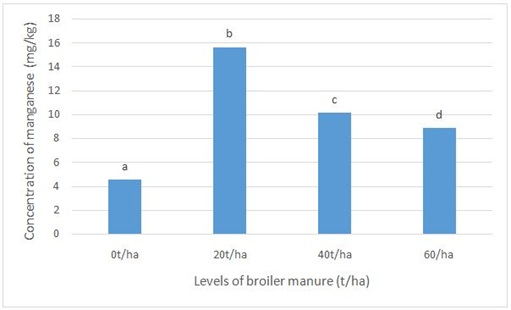 Figure 3: Manganese content of lettuce (Lactuca sativa) plants amended with various amounts of fresh broiler manure. Bars with same letters not significantly different from each other at P=0.05. Mean separation by DNMRT.
Figure 3: Manganese content of lettuce (Lactuca sativa) plants amended with various amounts of fresh broiler manure. Bars with same letters not significantly different from each other at P=0.05. Mean separation by DNMRT.Iron content
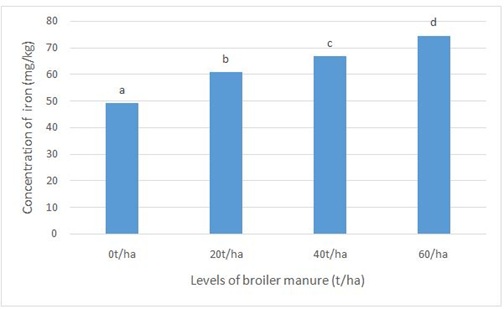 Figure 4: Iron content of lettuce (Lactuca sativa) plants amended with various amounts of fresh broiler manure. Bars with same letters not significantly different from each other at P=0.05. Mean separation by DNMRT.
Figure 4: Iron content of lettuce (Lactuca sativa) plants amended with various amounts of fresh broiler manure. Bars with same letters not significantly different from each other at P=0.05. Mean separation by DNMRT.Zinc content
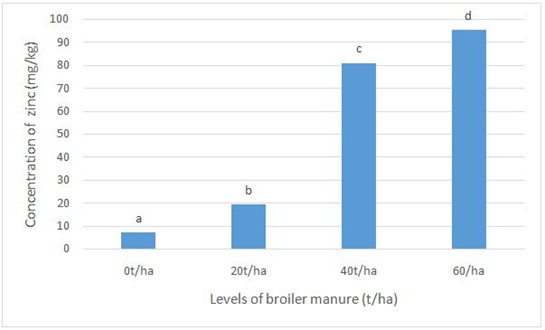 Figure 5: Zinc content of lettuce (Lactuca sativa) plants amended with various amounts of fresh broiler manure. Bars with same letters not significantly different from each other at P=0.05. Mean separation by DNMRT.
Figure 5: Zinc content of lettuce (Lactuca sativa) plants amended with various amounts of fresh broiler manure. Bars with same letters not significantly different from each other at P=0.05. Mean separation by DNMRT.Cadmium content
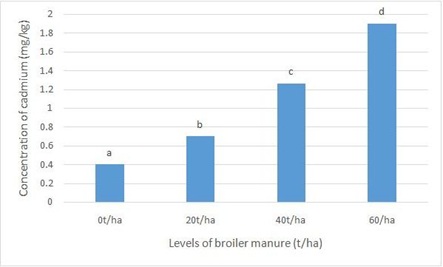 Figure 6: Cadmium content of lettuce (Lactuca sativa) plants amended with various amounts of fresh broiler manure. Bars with same letters not significantly different from each other at P=0.05. Mean separation by DNMRT.
Figure 6: Cadmium content of lettuce (Lactuca sativa) plants amended with various amounts of fresh broiler manure. Bars with same letters not significantly different from each other at P=0.05. Mean separation by DNMRT.Copper content
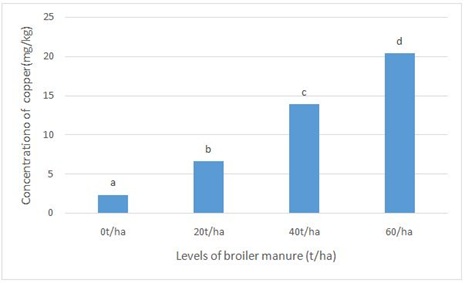 Figure 7: Copper content of lettuce (Lactuca sativa) plants amended with various amounts of fresh broiler manure. Bars with same letters are not significantly different from each other at P=0.05. Mean separation by DNMRT.
Figure 7: Copper content of lettuce (Lactuca sativa) plants amended with various amounts of fresh broiler manure. Bars with same letters are not significantly different from each other at P=0.05. Mean separation by DNMRT.DISCUSSION
There was a slight increase in Mn content in lettuce upon application of poultry manure and the content of this element decreased at the 40t/ha rate of poultry manure application. Compared to the increase from the control (0t/ha) to 20t/ha there was little increase of manganese content with increasing amount of fresh broiler manure application. The content of manganese was found to be below the WHO [14] permissible limit in all the treatments. This suggests that fresh broiler manure may not contain harmful amounts of manganese.
There was a significant increase in Cd content in lettuce with increasing rate of fresh broiler manure application. The highest amount of cadmium was obtained at the highest rate of application of this material (60t/ha), while the control recorded the least. The Cd content in lettuce was found to be above the World Health Organization WHO [14], permissible limit of 1mg/kg for plants amended with 60t/ha and 40t/ha. At the lowest application rate (20t/ha) cadmium content was found to be below the health hazard level. This means that the broiler manure applied above 20t/ha used in this study had elevated levels of Cd. This element is extremely toxic to humans and animals and its accumulation in the human body is linked to a number of ailments.
The content of iron in the plant material significantly increased with increased rates of application of fresh broiler manure. The content of iron was found to be below the permissible limit of 100mg/kg in all the treatments including the control. This may eliminate one more heavy metal fear in broiler manure; however, it does not guarantee the safe use of fresh broiler manure in vegetable production due to the possible accumulative effect of the heavy metals in the human body.
There was a significant increase in zinc content with increasing rate of fresh broiler manure application. This might be due to high content of zinc in the manure used in this study. The content of Zn in the control was 7.13mg/kg which is below the WHO permissible limit [14] and the content of this material increased to 95.10mg/kg at the highest amount of fresh broiler manure application (60t/ha). This suggests that vegetable produce grown in soils amended with fresh broiler manure may not be safe for human consumption since it is above the WHO permissible limit [14].
There was an increase in the content of copper in lettuce grown in soil amended with fresh broiler manure but the content of Cu was below the WHO permissible limit of 30mg/kg in all the treatments including the control [14]. This however, does not guarantee the safe use of poultry manure in vegetable production.
CONCLUSION
REFERENCES
- Norman JC (1992) Tropical vegetables crops. Arthur H Stockwell Ltd. Elms Court Il fracombe, Devon, UK.
- Eliot F (2005) Organic Farming in Scotland. Scotland, UK.
- Anonymous (2008) Organic farming as a sustainable vegetable production to provide better vegetable quality.
- Murdoch G (1970) Soils and land capability in Swaziland. Swaziland Ministry of Agriculture, Mbabane, Swaziland.
- McLean EO (1982) Soil pH and lime requirement. In Page AL, Miller RH, Keeney DR (eds.). Methods of soil analysis. Part 2-Chemical and microbiological properties. (2nd E). American Society of Agronomy. Madison, Wisconsin. USA.
- Lanyon LE, Heald WR (1982) Magnesium, calcium. strontium and barium. In Methods of Soil analysis. Part 2: Chemical and microbiological propertie (2nd Ed.). Page AL, Miller RH, Keeney DR (eds.). American Society of Agronomy. Madison, Wisconsin. USA.
- Knudsen D, Peterson GA, Pratt PF (1982) Method of soil analysis, Agronomy no.9, Part 22nd Ed.). Soil Science Society of America, Madison, Wisconsin, USA.
- Oslen SR, Somers S (1982) Soil Nutrients bioavailability: A mechanic approach (2nd). John Wiley and sons New York, New York, USA.
- Zaranas BA, Cartwright B, Spouncer LR (1987) Nitric acid digestion and multi element analysis of plant material by inductively coupled plasma spectrometry. Journal Communications in Soil Science and Plant Analysis 18: 134-146.
- Nissen O (1989) MSTAT-C: A micro computer program for the design and management and analysis of agronomic research experiments, Michigan State University, East Lansing. Michigan, USA.
- Gomez AA, Gomez KA (1984) Statiatical procedures for agricultural research (2nd ). John Wiley and Sons, New York, USA.
- Rao MK (1991) Text book of horticulture. University of Madaras, Madaras, India.
- Xu HL, Wang R, Xu RY, Mridha MAU, Goyal S (2005) Yield and quality of leafy vegetables grown with organic fertilizations. Acta Hort 627: 25-33.
- WHO (1997) Standards for heavy metals in foods and supplements. World Health Organization, Geneva, Switzerland.
Citation: Sibeko MT, Masarirambi MT, Wahome PK, Oseni TO (2019) Heavy Metal Accumulation in Lettuce (Lactuca Sativa L.) Amended with Different Amounts of Fresh Broiler Poultry Manure. J Agron Agri Sci 2: 016.
Copyright: © 2019 Sibeko MT, et al. This is an open-access article distributed under the terms of the Creative Commons Attribution License, which permits unrestricted use, distribution, and reproduction in any medium, provided the original author and source are credited.

